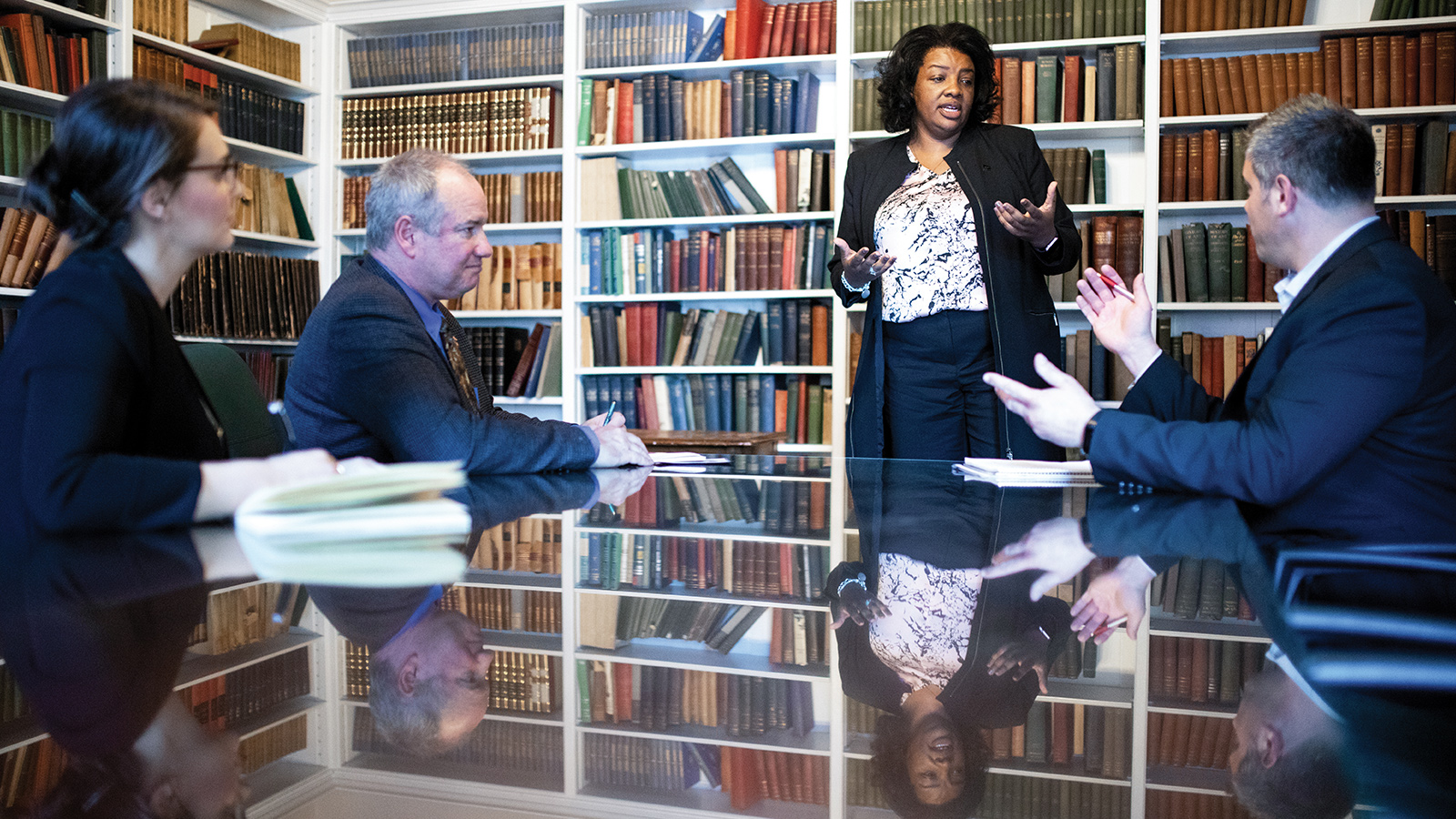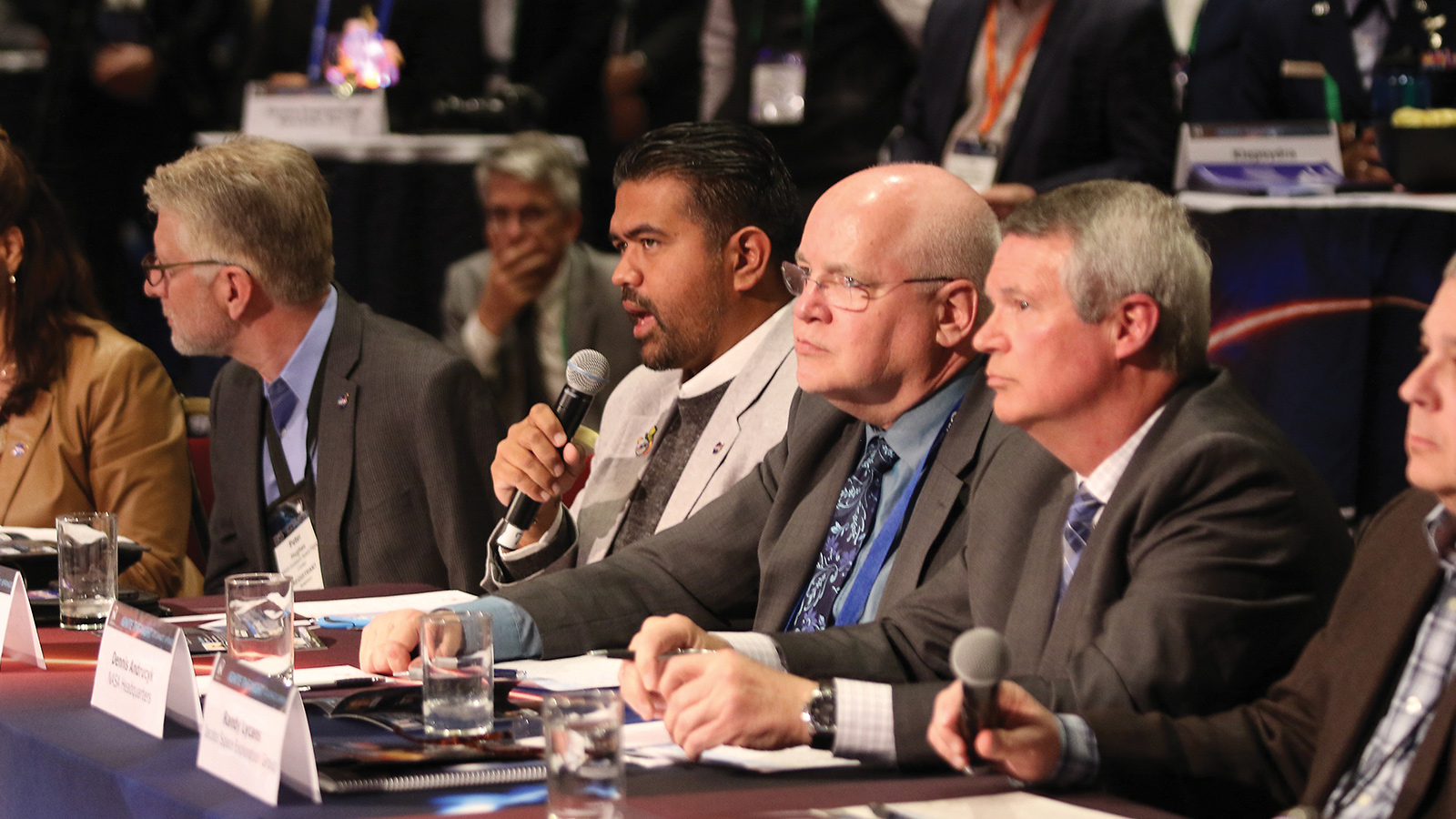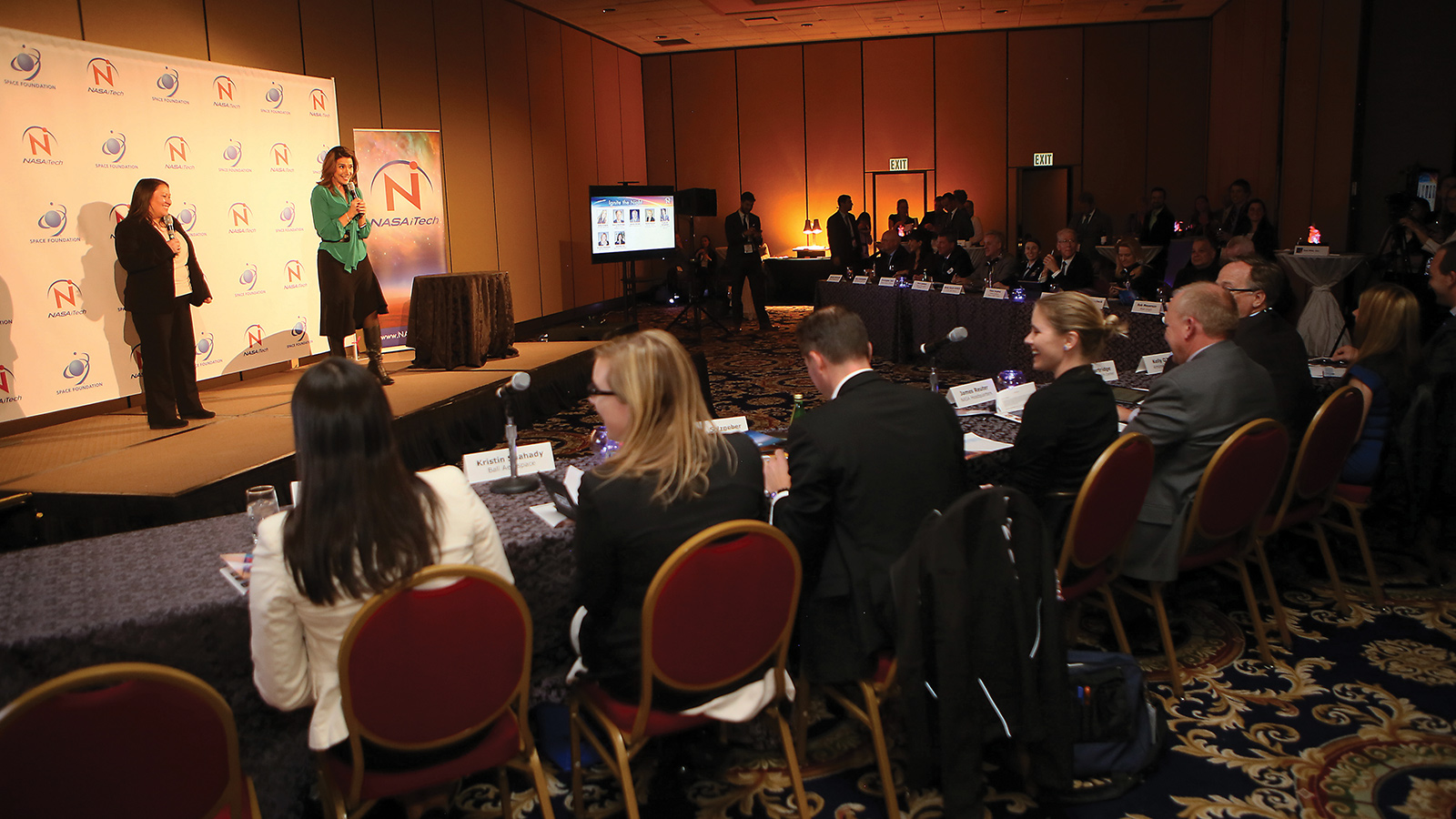Stay Up to Date
Submit your email address to receive the latest industry and Aerospace America news.
NASA and the Pentagon want to be more open to innovative ideas from entrepreneurs and business development managers, and they are creating in-person opportunities to hear from them. The catch is that it can be nerve-wracking to try to convince members of an audience to buy a product, invest in it or just believe in it. Amanda Miller shares advice from veteran pitchers.
I don’t know if you heard recently, in the news? There was an incident in an Antarctic isolation study. One crew member stabbed another crew member.”
The audience quieted down, and entrepreneur Alires Almon had our undivided attention.
She was one of about a dozen small-business executives who gathered in Denver to make elevator pitches at last November’s Innovation and Opportunity Conference, a first-of-its-kind, NASA-sponsored event that I attended, where government agencies were put in contact with new players and vice versa.
Almon was pitching her company’s idea for a computer-based method to predict human behavior.
She continued: What precipitated the stabbing? The victim hadn’t hoarded food or slacked on chores. “They stabbed ’em because they were telling the ending of books that they were reading.”
The new method would have diffused the tension to “more of a verbal argument, or better yet, prevented it altogether.”
Within a couple of minutes, we all knew what her company, Deep Space Predictive, is all about: empowering teams of space explorers to get along and manage any disputes peacefully.
This was Almon’s debut pitching the idea publicly, but she was able to draw on her experience in public speaking in other contexts. Not everyone adapts as easily to the art of the pitch.
The crop of aerospace entrepreneurs I’ve met at industry events over the past year mostly uttered variations on “nerve-wracking” to describe the experience of pitching their ideas in front of an audience of investors or government acquisition officers. Here are some lessons from them, along with advice from pitch insiders.
Business case
A frequent pitfall for aerospace startups is focusing on the technology while giving “zero thought to actual business,” says Rachel Cheetham, the Rocky Mountain regional director for the U.S. Defense Department’s NSIN, for National Security Innovation Network. “You come in with a high TRL” — technology readiness level — “but your business readiness is nothing.”
Traditionally, the military has learned about industry capabilities through informal conversations in centralized offices, followed by official paperwork submitted in response to requests for information or broad agency announcements. The 4-year-old innovation office provides new avenues.
NSIN, which changed its name in May from MD5, puts on pitching contests, among other events such as collegiate “hackathons,” and tracks tech startups with the aid of regional portfolio managers such as Cheetham. She may connect a company with investors; help find a place to build a prototype; or go back to military units, such as those at the Air Force bases in Colorado Springs, to get ideas for product improvement.
Cheetham headed up a pitch contest in Denver last October. On hand to present, judge and watch were several hundred people drawn from the service branches, the intelligence agencies, and the research and private investment communities. The winner got $5,000, but the real prize was getting to pitch in front of that crowd.
Of 30 companies that submitted videotaped pitches, five got to make live presentations.
The five finalists in October got through because they made a business case — they could “clearly articulate the value proposition,” Cheetham says.
Group goal
A subscriber to the pitching school of thought that “all exposure is good exposure,” Michael Hurowitz took the podium as one of NSIN’s final five in Denver to describe how a constellation of microwave-detecting, three-unit-long cubesats could map temperatures and precipitation around the world, amounting to a new source of weather data for the airlines and others.
Hurowitz is chief technology officer and senior vice president of engineering for Orbital Micro Systems of Boulder, Colorado, and one of seven co-founders from the local science community. The staff of 15’s first technology-demonstrator cubesat went into orbit on a resupply flight to the International Space Station in April and is waiting to deploy, probably in July, depending on astronaut schedules.
Hurowitz thinks more doors will open in terms of customer interest once that first satellite starts sending home data. “There’s a high bar in this industry to be taken seriously,” he says.
When he travels to conferences for business, Hurowitz prioritizes events that bring together people from other industries outside the space sector. Besides aviation, agriculture is another industry that Orbital Micro wants to grow.
Hurowitz says he most values the chance to present in front of a group like at the NSIN pitch contest:
“Now people know who you are, and if they think you have something to talk about, they can come find you,” he says.
Talk it out
The Air Force hosts its own technology accelerator for small businesses in Colorado Springs apart from NSIN. The day before we talked for this story, co-founder and CEO Rod Goossen of Denver-area startup RoGo Fire had pitched there.
An avionics engineer, Goossen got the idea to start a company after something his brother, a wildland firefighter, said following the Yarnell Hill Fire that trapped and killed 19 firefighters in Arizona in 2013.
“I said, ‘How could this happen?’” Goossen recalls. “He said, ‘We’re still using paper maps, compasses and two-way radios.’”
RoGo Fire’s founders want to relay real-time information to wildland firefighters by satellite — data including weather, texts, firefighters’ own whereabouts, that of others, and of equipment. He and two partners, including his brother, have moved the business into a coworking space to work on an early iteration that will plug into an off-the-shelf tablet. The facility caters to companies making things out of electronic components.
Aside from a possible National Guard activation, the military doesn’t fight wildfires, but Goossen was glad he got to pitch for the Air Force accelerator anyway. It turns out a system like RoGo Fire could be useful in a combat scenario.
As the CEO and technical expert, Goossen does all the pitches.
“It’s taken some work. I think it’s come to me easier than it would come to many people. But still, I’m in no way saying I’m great or even good at it,” he confesses.
Even things like nonverbal gestures factor into the delivery style.
“It’s absolutely necessary for any pitch to be practiced in front of a nonintimidating crowd,” he advises.
Head start
The University of Colorado-Boulder plans to get engineering students up to speed on pitching by offering a minor in engineering entrepreneurship starting in the fall.
The “problem-rich environment” of the space sector promises lots of opportunities for future entrepreneurs, says Kyle Judah, director of entrepreneurship in the university’s College of Engineering and Applied Science, who was wooed away from MIT.
One new class will guide students through the “venture-building process” from an idea through production of a working prototype — a lot like what the venture world calls a “startup weekend,” Judah says, but stretched over a whole semester and providing “a much better idea of, ‘Is this viable or not?’
“The majority of ventures that start in a classroom, or on a campus, will never translate into an industry,” Judah says. “It’s about helping develop the entrepreneurial mindset and skill set to do it.”
Part of the university’s strategy has been to host startup weekends on campus. One was a privately run, pitch-intensive, space-themed startup weekend held last October. Entrepreneurially spirited students, alongside executives from a few small companies around Colorado, divided into teams and made pitches all weekend, aiming for the first-place prize of an invitation to pitch at the Satellite 2019 conference in Washington, D.C., in May.
To get warmed up, the actual and aspiring entrepreneurs had to improvise a pitch from a set of ideas that people randomly yelled out.
Many ways to win
The weekend culminated in a round of pitches made for a panel of judges, all experts in entrepreneurship or members of the space industry.
CU Boulder engineering physics major Kathy Vega stood up to make her final pitch. Several competing ideas were made up largely to practice the business-building process, but not Vega’s.
“As a student studying engineering, I’ve had the opportunity to work on cubesat missions,” she told the judges. “I spent hours and hours just sourcing the supplies and materials we needed for our cubesat. In fact, one time I was looking for a hinge. [Hinges] are very important for building solar panels on cubesats. It took me weeks just to find a supplier for this hinge and then a couple more weeks to get on the phone with someone so I could get a [price] quote.
“Our solution is to create one central marketplace for cubesat products. This center would have all the information you need on all the parts you need — so hundreds of hours of engineering labor in just a few hours of point and click.
“And this isn’t just useful for those creating the cubesat, but it’ll be a great value for the current suppliers of cubesat parts because we would be able to generate new leads for these suppliers as well as create new customers.
“After speaking with some suppliers, right now the best way to do this is driving from conference to conference or calling up different places to try to sell their product,” Vega said.
She didn’t win — other teams scored higher on teambuilding aspects that weekend — but the judges deemed her idea the most likely to be a real business one day, and one of them stayed on as a mentor.
Cross the “t” in customer
In the weeks leading up to her March testimony on human space exploration before the National Space Council, Wanda Sigur tells me she’s made pitches over the years and heard a lot of them — “That’s pretty much the nature of the game, of course.”
An independent consultant and adviser for space startups since 2017, when she retired from Lockheed Martin Space Systems as a civil space programs vice president and general manager, she tells me the story of a recent pitch gone wrong.
A startup company wanted $30 million from investors to build a production facility. The company had demonstrated a product, and the executives had customers in mind: “They were focused on large primes, but they had no letters of intent, no commitments — nothing,” Sigur says. A pitch asking for such a “big chunk of money” as $30 million, without documented customer interest, “left folks a bit cold.”
To get good investors onboard, Sigur tells entrepreneurs they should demonstrate credibility and a history of turning an idea into a product; and show that they’ve assessed risk, cost, customers and the competition.
Wild pitch
As a civilian working for various Defense Department offices over the years, including eight years at the U.S. Missile Defense Agency, Shane Deichman made internal pitches for technologies that he wanted to develop, and he heard contractors make pitches.
One pitch in particular was memorable. “We had one major defense prime — one of the big top five primes — their guy came in and proceeded to lecture us,” Deichman recalls. The beef had to do with perceived corporate bias in the proposal process.
“I thought, ‘You’re one of the most massive defense primes in the history of the world, and you’re coming in and lecturing us?’” says Deichman, who now heads business development for Teledyne Brown Engineering. “The best pitches always have a little bit of give and take. They really are a conversation, a two-way dialog.”
Business booster
The Space Foundation in Colorado Springs, Colorado, has created a series of free video webinars aimed at helping space entrepreneurs. Among the 15 videos are “The Future of Space Commerce,” “Intellectual Property in the Aerospace Industry,” “Space Law” and “Growing Your Business.” The videos were made with a grant from the U.S. Commerce Department’s Minority Business Development Agency.
“It’s absolutely necessary for any pitch to be practiced in front of a nonintimidating crowd.”
Rod Goossen, CEO and co-founder of startup RoGo Fire
About Amanda Miller
Amanda is a freelance reporter and editor based near Denver with 20 years of experience at weekly and daily publications.
Related Posts
Stay Up to Date
Submit your email address to receive the latest industry and Aerospace America news.







